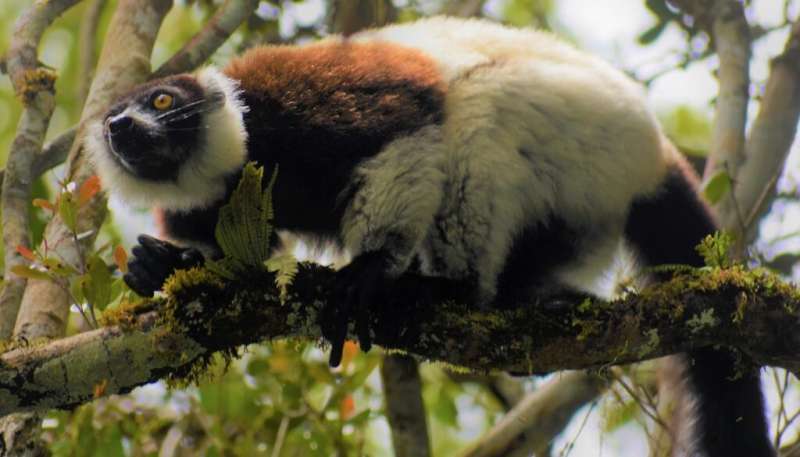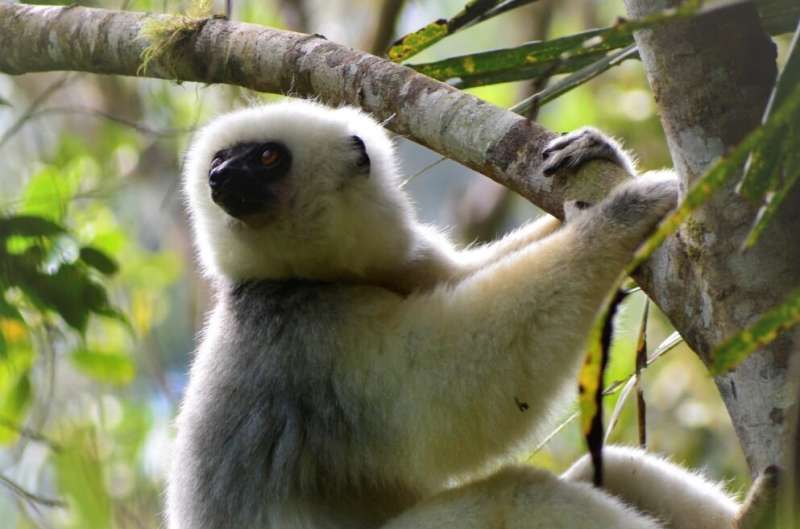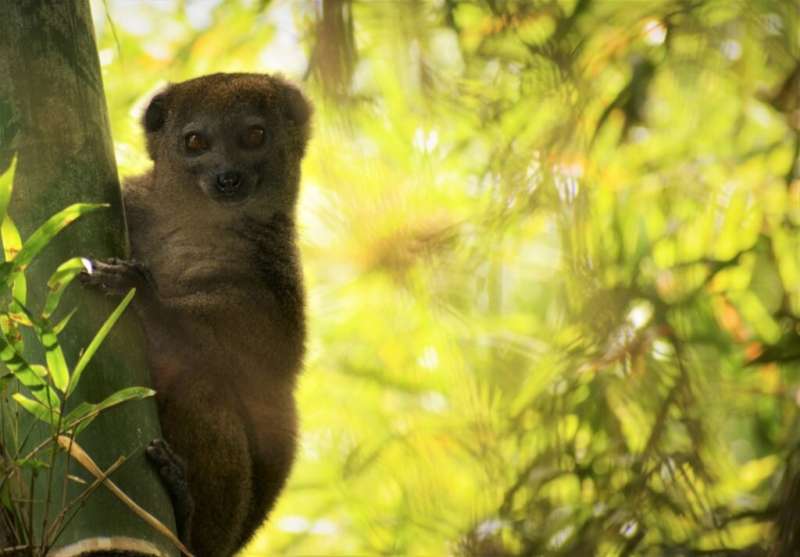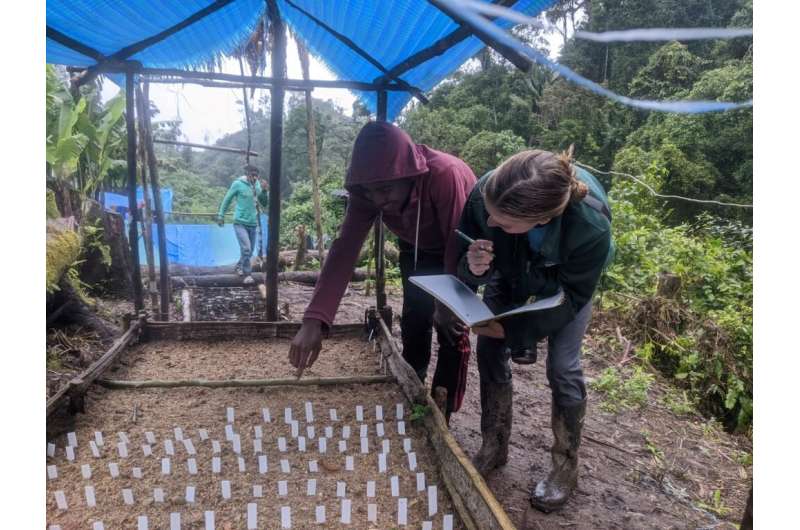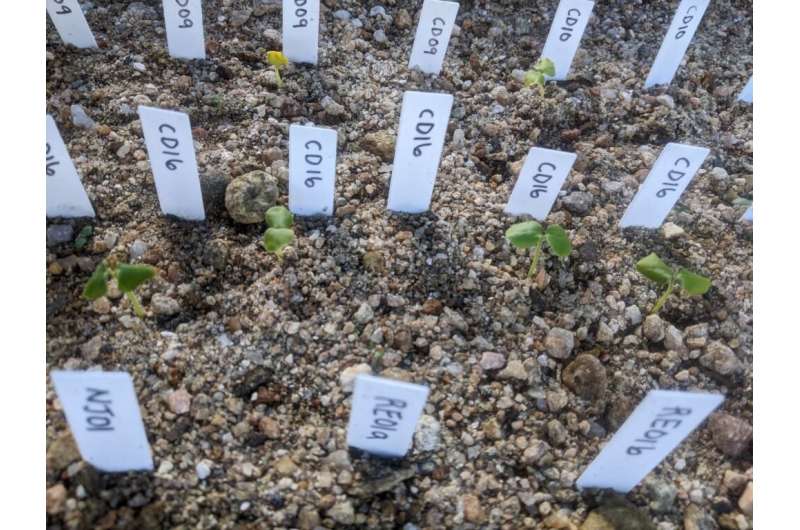The Critically Endangered black-and-white ruffed lemur, Varecia variegata, is one of the lemurs that eats the most fruit. When they consume the fruit, they pass the whole seed far from the mother tree, effectively aiding in seed dispersal. Credit: Laura De Ara
New research shows that lemurs and their food trees are tightly linked in ecological networks, and that the extinction of lemurs will have cascading effects on ecosystem functions.
Lemurs are the primates found only on Madagascar. They are unique in many ways, and like many organisms, they fit in complex ecological networks. These networks include interactions between lemurs and their food trees. Many interactions are beneficial, or mutualistic; for example, lemurs eat the fruits of trees and disperse their seeds, providing a critical service to the trees. If lemurs go extinct—98% of species are threatened with extinction due to human activities—the links in the ecological network will be severed, with potentially negative impacts on the trees.
Research published in the Journal of Animal Ecology by Ph.D. student Camille DeSisto, of the Duke University Nicholas School of the Environment, and James Herrera, from the Duke Lemur Center, shows how tightly linked lemurs and trees are in their interaction networks, and the negative impacts of extinction on network resilience. If lemurs do in fact disappear, many trees will be left without a way to disperse their seeds, and may not be able to reproduce effectively.
The silky sifaka, Propithecus candidus, is one of the most endangered primates in the world. Unlike some lemurs, the sifaka have antagonistic relationships with trees, eating leaves and prey on seeds, rather than passing them intact. Credit: Laura De Ara
DeSisto and Herrera used advanced techniques in social network analysis, including exponential random graph models, to test which traits of lemurs and trees predict their probability of interaction. The lemurs with the highest probability of interactions with trees were large, fruit-eating species with a short gestation length, occurring in arid habitats, and with a threat status of Least Concern. Closely related plants were more likely to interact with the same lemur species than distantly related plants, but closely related lemurs were not more likely to interact with the same plant genus.
Simulated lemur extinction tended to increase network structure in some properties, including connectance (percentage of realized interactions out of all possible interactions) and modularity (how many unique cliques or subcommunities form in the network), but decrease nestedness (the tendency for specialists which feed on only a few trees to be a subset of generalists which feed on many trees) and robustness (tolerance to future extinctions), compared to pre‐extinction networks. Networks were more tolerant to plant than lemur extinctions.
By simulating the loss of lemur and plant species, the authors could predict how network structure will erode over time if threatened lemurs and trees go extinct. The results showed that if the most well-connected lemurs in the network were to disappear, the percentage of trees with interactions would quickly decline, compared to scenarios in which lemurs were removed randomly or if the least-well connected lemurs went extinct. Given the threat status and geographic range size of lemurs, the percentage of trees that would lose their interacting lemurs would be greater than that expected if lemur extinctions were random.
-
The bamboo lemur, Hapalemur occidentalis, is a highly specialized species, eating mostly bamboo leaves. They do, however, occasionally eat fruits, and often spread the seeds effectively. Credit: Laura De Ara
-
Author Camille DeSisto and assistant Feno Telessy examine the seeds germinating from lemur feces. Credit: Duke Research Blog
-
Amazingly, seeds from lemur feces are already germinating after only one month. Some tree seeds take months or even a year before germinating. Credit: Duke Research Blog
Results also showed that if lemurs go extinct, the resilience of the networks to further disturbance would decrease. This indicates that the current links between lemurs and trees are critical to the stability of these complex ecological networks.
To prevent the loss of key ecosystem functions like seed dispersal, it is critically important to protect lemurs and trees, which depend so crucially on one another for survival. DeSisto is currently conducting field research in Madagascar, studying how well seeds germinate when eaten by lemurs. She created a tree nursery in the forest to grow the seeds obtained from lemur feces, and already has several species germinating. Interestingly, she is also showing how lemurs disperse the seeds of vines, which are an important yet understudied food source when tree fruits are not available. She will continue her research across multiple seasons, to determine how changes in plant phenology affect seed dispersal patterns.
Many conservation programs are currently striving to safeguard Madagascar forests and the diverse species found only in these natural habitats. The Duke Lemur Center has an active conservation program in the northeast, called the DLC-SAVA Conservation Initiative. This program takes a community-based approach to conservation, partnering closely with local stakeholders and actors to develop projects that address the needs of both lemurs and people. By co-creating projects that include alternative and sustainable livelihood strategies, both nature and people benefit from conservation. Natural ecosystems provide important services for people, including locally, such as protecting watersheds and pollinators, as well as globally, such as carbon sequestration. Without the native forests, and the lemurs that call those forests home, people would lose the valuable and irreplaceable services forests provide.
More information: Camille DeSisto et al, Drivers and consequences of structure in plant‐lemur ecological networks, Journal of Animal Ecology (2022). DOI: 10.1111/1365-2656.13776
Journal information: Journal of Animal Ecology
Provided by Duke University
